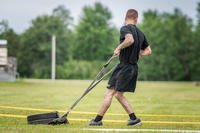With battles in an urban environment becoming a part of daily life for both overseas troops and our own police officers in America, the need-for-speed programs never have been more applicable to today's civil servants.
There is a need for speed in the military and law enforcement professions. More agencies around the United States are adopting the 300-meter run in addition to the 1.5-mile run as part of testing protocol for candidates as well as maintenance programs for military and law enforcement. For instance, the FBI uses the Cooper Institute physical testing procedures, along with about half of the police department in the U.S. Some departments are adding shuttle runs, agility tests and vertical jumps to build speed and explosive power, which is needed in today's urban combat environments.
Cardiovascular endurance usually is measured with the 1.5-, two- or three-mile run in most branches of the military, but now many local, state, and federal law enforcement departments and agencies are adding the 300-meter run. This challenges many of the applicants more than push-ups and sit-ups.
So speed training should be introduced to your training programs. Quite frankly, speed training should be added into every soldier and police officers program, as it could be that half-second faster you get to cover when the shots are coming in your direction that makes all the difference.
The following chart is designed for the Cooper Institute cardio tests used by many law enforcement departments at all levels of government. Many applicants have trouble with the 300-meter sprint, followed by the 1.5-mile run; this is how to remedy that challenge. This is a supplemental running program that combines endurance and speed workouts to help with running stamina, endurance, pace and speed.
|
Day 1 Run and Leg PT |
Day 2 |
Day 3 Distance Day |
Day 4 Run and Leg PT |
Day 5- Pace Day (rest as long as you run) |
Day 6/7 |
|
|
Week 1 |
1. Mile run warmup Repeat two times 300-meter run Squats 20 Lunges 10/leg |
Run 300 meters -- rest 5 minutes -- run 1.5 miles timed |
Run 1.5 miles at close to goal pace x2 -- rest 10 minutes in between |
Warm-up jog for 10 minutes Repeat five times 300-meter run Squats 10 Lunges 10/leg |
Warmup jog for five minutes Run quarter-mile at goal pace, half-mile at goal pace, three-quarters of a mile at goal pace, one mile at goal pace. Stretch |
Day off |
|
Week 2 |
1. Mile run warmup Repeat three times. 300-meter run Squats 20 Lunges 10/leg |
Run 300 meters x2 -- rest five minutes -- run 1.5 miles timed. |
Three miles at close to goal pace |
Bike pyramid: Manual mode level 2, 4, 6 ... hold each level for one minute until failure -- repeat in reverse order -- should be 15-20 minutes long. |
Warmup jog for five minutes. Run quarter-mile at goal pace, half-mile at goal pace, three-quarters of a mile at goal pace, mile at goal pace. Run 1.5 miles |
or |
|
Week 3 Easy Run Week |
Bike pyramid: Manual mode level 2 , 4, 6, ... hold each level for one minute until failure. Repeat in reverse order. Should be 15-20 minutes long. |
Run 300 meters x3 -- rest five minutes -- run 1.5 miles timed. |
Swim, elliptical glider or both -- 30 minutes of either or both |
Warm-up jog 10 minutes Repeat five times. 300-meter run Squats 10 Lunges 10/leg Run 1.5 miles |
Bike pyramid: Manual mode level 2, 4, 6, ... hold each level for one minute until failure -- repeat in reverse order -- should be 15-20 minutes long. |
Makeup day |
|
Week 4 |
Run sprints warmup at 50% for 100 meters x3 Full speed at 100 meters x3 200 meters x2 300 meters x1 (work/rest ratio = 2:1) Run 1.5 miles timed |
300-meter timed bike pyramid: Manual mode level 2, 4, 6, ... hold each level for 1 minute until failure -- repeat in reverse order -- should be 15-20 minutes long. 1.5-mile run |
3 miles easy |
Warmup for five minutes. Repeat six times. Run quarter-mile at goal 1.5-mile pace Squats 20 Lunges 15/leg Sit-ups 30 in 30 seconds Run 1.5 miles timed |
1.5-mile timed run Rest five minutes. One-mile run at goal pace Rest four minutes. Run three-quarters of a mile at goal pace. Rest for three minutes. Run half-mile at goal pace. Rest for two minutes. Sprint 300 meters timed |
|
|
Week 5 |
FBI test Sit-ups for one minute 300-meter sprint Push-ups for one minute 1.5-mile run Pull-ups |
Bike pyramid or elliptical glider pyramid |
Run 3-5 miles. |
300-meter sprint Rest for one minute 1.5-mile run |
8x a quarter-mile at goal pace -- rest for two minutes -- 4x 300-meter sprints -- rest for two minutes |
If you have any questions, please feel free to email me at stew@stewsmith.com and visit the Military Fitness Center for the article archive for more information (books, eBooks, articles, video) on working out.
Good luck and enjoy the workouts -- Stew Smith CSCS
Stew Smith is a former Navy SEAL and fitness author certified as a Strength and Conditioning Specialist (CSCS) with the National Strength and Conditioning Association. Visit his Fitness eBook store if you're looking to start a workout program to create a healthy lifestyle. Send your fitness questions to stew@stewsmith.com.
Want to Learn More About Military Life?
Whether you're thinking of joining the military, looking for fitness and basic training tips, or keeping up with military life and benefits, Military.com has you covered. Subscribe to Military.com to have military news, updates and resources delivered directly to your inbox.



















